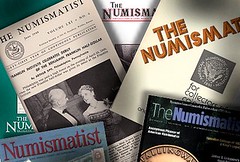
PREV ARTICLE
NEXT ARTICLE
FULL ISSUE
PREV FULL ISSUE
THE JOYS OF BACK ISSUES OF THE NUMISMATIST
Charles Morgan and Hubert Walker published an article in CoinWeek September 24, 2013 about the great information to be found in back issues of The Numismatist, the monthly publication of the American Numismatic Association. They focused on four particular issues as examples. Here's an excerpt, but be sure to read the complete article online.
-Editor
Hubert and I comb relentlessly through old books and magazines, and auction catalogs. We do this to learn not just the stories behind the coins, but also the stories behind the stories. Books are great for that, sure, and a good catalog is a masterful blend of the technical and the legendary. However, for our money (literally, and not a lot of it*), old magazines are where it’s at. Individual issues are snapshots of the hobby as it was at the time of publication, and are full of insights that can only help you as a collector. They have the power to transform your collecting goals and lead you in new and exciting directions. Taken as a whole, a year’s or even a decade’s worth of magazines puts you in the middle of the action, and the hobby of the past becomes a living thing once more.
Bibliophiles and researchers take note - as much as we love diving into 19th century literature, often the best word on a topic is modern. Their picks are relatively recent issues, within the lifetimes of most of our readers. Below I'll list the issues and an excerpt on one example article they cited.
-Editor
February 1986 So groundbreaking is the article that it remains essential reading on the Heraldic Eagle-type Washington quarter reverse, and is often quoted by Q. David Bowers and others when describing the different reverse hub changes that have occurred throughout the series." July 2002 Alexander covers all the bases, from the production and subsequent melting of the ‘33 double eagle, to attempts to sell the coins over the years – including the Flanagan, Berenstein, Boyd, Bell, Reed and Eliasberg specimens. The Reed specimen was actually advertised by Smith & Sons, a Chicago coin dealership, in the February 1941 issue. July 1984 March 1985 The piece traces the coin’s origin back to attempts to construct a monolithic sculpture of Jefferson Davis, Robert E. Lee and Stonewall Jackson on the side of Stone Mountain in Georgia. Plans for the work go as far back as 1912. The coin wasn’t issued until 1925, and the actual sculpture wasn’t finished until 1972, after fits and starts and heaps of controversy. Of all the “shenanigans associated with the issuance of [commemorative] half dollars”, Hyder and Colbert point out, “none is more mysterious than the variety of schemes devised to sell the Stone Mountain half dollar”.
To read the complete article, see:
From the Vaults: Four Essential Back Issues of The Numismatist
(www.coinweek.com/education/vaults-four-essential-back-issues-numismatist/)
The Numismatic Bibliomania Society is a non-profit organization promoting numismatic literature. See our web site at coinbooks.org. To submit items for publication in The E-Sylum, write to the Editor at this address: whomren@gmail.com To subscribe go to: https://my.binhost.com/lists/listinfo/esylum All Rights Reserved. NBS Home Page Contact the NBS webmaster 
|
